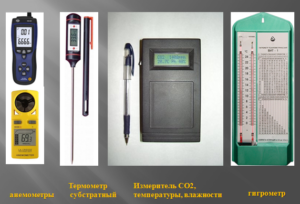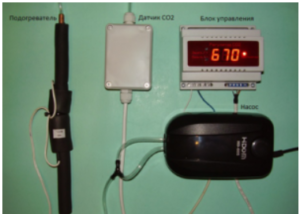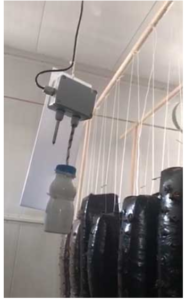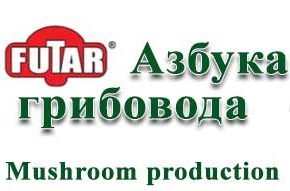Instruments necessary for oyster mushroom cultivation
Instruments necessary for oyster mushroom cultivation
For the stable operation of the mushroom enterprise and high production yields, we need a well-adjusted microclimate as well as constant monitoring of all its parameters.

Анемометр-Anemometer
Термометр субстрактный-
Substrate thermometer
Измеритель СО2,температуры,влажности-
CO2, temperature and humidity measuring instruments
Гигрометр-Hygrometer
Unfortunately, many mushroom growers (especially those with a small scale of mushroom production) use household electronic instruments for temperature, humidity and CO2 monitoring, which are not designed for operation in high humidity and corrosive environment.
In fact, water condensate depositing on the internal parts of sensors contains dissolved CO2 (carbon dioxide). It promotes corrosion of metal parts, contacts, electronic boards and, as a result, leads to a significant distortion of the measured readings.
In addition, the admissible error for household instruments (usually +/- 5%) is unacceptable for the growing chambers’ microclimate, where changes of any parameter even by 1-2 points can cause deformation and death of fruit bodies.
Apparent cheapness of some “Chinese handicrafts” in fact turns out to be very expensive: due to high humidity, such equipment breaks down in just three to four months of operation, and we have to buy those “cheap” devices again. Such instruments and sensors, are practically impossible to calibrate, to make sure their readings are correct.
You can do without instruments and sensors at all, determining, which microclimate parameters are not optimal by the mushrooms themselves (on our website we have many photos of deformed mushrooms with an explanation of reasons).
Another option would be to buy a quality equipment designed for professional use in high humidity conditions, with a manufacturer’s warranty and use it for more than one year, being confident about its stable operation and correct readings.
Monitoring all the readings of sensors is not enough, it is necessary to properly record them in a journal – at least once per hour. However, it would be ideal to purchase recorders or loggers capable of recording and storing readings in their nonvolatile backup memory.

Подогреватель-Heater
Датчик СО2-CO2 sensor
Блок управления-Control unit
Насос-Pump
It is much better, if you have a computer program which not only records the readings of temperature sensors, humidity and CO2, but also can make adjustments via actuators to maintain predetermined microclimate conditions.
It is necessary to record the microclimate parameters because visual manifestations of fungal death or deformation appear only after a few days. Reading a log, you can see when there were sudden changes of humidity and/or temperature, CO2, and understand their origins. Also you will be able to determine which particular parameter swings affected the mushrooms most damagingly. You can read more here.
Which humidity sensor is better?

If you want to purchase an electronic humidity sensor, make sure it is designed to operate in a high humidity range. Carefully read the instructions on where you can install the sensor, whether you need an airflow blow-off, etc. In addition to the electronic sensor, it is also desirable to have a hygrometer to verify the readings of the instruments. It is also desirable at least once a year to carry out calibration at the instrument manufacturer’s facilities or in the specialized laboratories.
Another device you need to have at your enterprise is an anemometer. It would seem, why do you need it all the time? Invite a competent ventilation specialist once, adjust the airflow – and that’s it!
However, you must bear in mind that over time, certain ventilation problems accumulate which can be invisible at first. For example, the filter gets clogged, the number of revolutions on the fan motor decreases, the lateral air duct collapses, the nozzle cups drop out or get jammed with debris (most often plastic film debris) – and the flow decreases dramatically.
But if something wrong is happening with mushrooms – curved or thickened mushroom stipe, twisted or over-soaked fruit bodies, the flow velocity is often not taken into account. If there is an anemometer at the enterprise, the technologist, by checking its readings, can measure and record the airflow rate at several points of the growth chamber daily.
